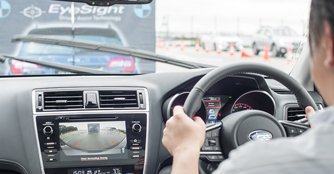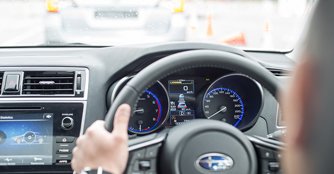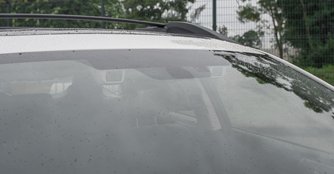Subaru EyeSight makes driving safer but doesn't replace drivers
16 Jan 2018|15,993 views
At the recently concluded Singapore Motor Show 2018, Motor Image unveiled the updated Subaru Outback and the Subaru XV 2.0i-S, which would replace the XV 1.6i-S for VES reasons. But strangely, it's not these new models that have got tongues wagging. Instead, it's news of EyeSight finally arriving on our shores that has.
And what's EyeSight again?
EyeSight is Subaru's proprietary driver assist system, which uses a range of functions to assist drivers in making decisions in order to provide for safer and more comfortable driving, as well as to reduce driver fatigue.
Under the right circumstances, it will apply the brakes or reduce the throttle to minimise the risk of a collision.
Subaru says EyeSight is designed to help assist drivers, not replace them. And unlike other major automakers who are racing to develop driverless cars, Subaru is taking a slower approach, as autonomous features remain costly for the buyers of Japan's smallest carmaker.
In Singapore, EyeSight will be made available on the compan's latest XV, Outback, Legacy, Impreza and Levorg models. When asked why the ever-popular Forester isn't available with EyeSight, a representative hinted at a coming update of its best-selling sport utility vehicle, which is expected to arrive some time later this year that will then come equipped with EyeSight.
From what we've been told, there's no price difference for models equipped with EyeSight and without. In fact, most EyeSight-less models will only be brought in on indent basis from hereon. This is to encourage and promote adoption and usage of the system.
So how does it work?
EyeSight uses stereo cameras to process stereo images and identify the vehicle in front, obstacles, traffic lanes and other items. Under the right circumstances, it will apply the brakes or decrease the throttle to help reduce the severity of, or help avoid a collision.
However, because it uses cameras instead of radars, EyeSight isn't all-perfect.
Sun glare, inclement weather or a dirty or cracked windscreen will hinder EyeSight operation or impede its performance. EyeSight may also not recognise low-contrast objects and anything below a metre tall.
Subaru admits that EyeSight may not operate optimally under all driving conditions and at the end of the day, the driver is always responsible for safe and attentive driving. But when it's working at its peak, it does so beautifully. All 2017 EyeSight-equipped Subaru models received the highest possible 2017 rating for front crash prevention by the Insurance Institute for Highway Safety in the U.S.A.
It is the collective of six systems and they are...

Pre-Collision Braking warns the driver with a buzzer and a warning light on the dash.
If the driver still does not take evasive action to avoid the collision, the system can automatically apply the brakes to reduce any impact or, if possible, prevent the collision. If the driver takes evasive action to avoid a collision, it helps prevent it from happening.
2. Adaptive Cruise Control
Adaptive Cruise Control combines the benefits of Cruise Control with active monitoring of the road ahead by EyeSight, and it issues warnings and activates automatic braking when needed.
Adaptive Cruise Control can regulate vehicle speed in order to keep a safe following distance from the car ahead and does not replace conventional Cruise Control, which can still be used when desired. It can be used at up to speeds of 180km/h.

When EyeSight recognises an obstacle or vehicle in front of you and you put the vehicle in Drive instead of Reverse, Pre-Collision Throttle Management sounds several short beeps, turns on a flashing indicator and cuts the engine output to help you avoid a frontal collision.
It's designed to help prevent drivers from accelerating into a stopped vehicle or other obstacle in front of them, especially useful in our cramped multi-storey carparks.
4. Lane Departure Warning
This one's rather self-explanatory. When travelling at speeds of 50km/h or more and you drift to the edge of your lane and begin to depart your lane without signalling, it warns you before you leave your lane.
However, unlike more advanced systems, it takes no corrective vehicle action to steer it back in its lane.

Lane Sway Warning helps fatigued drivers stay alert with a buzzer and a flashing indicator when EyeSight senses erratic lane discipline.
However, it only activates at speeds of approximately 60km/h or more, and after several minutes of left and right swaying.
6. Lead Vehicle Start Alert
When you're at a stop and Lead Vehicle Start Alert senses that the vehicle in front has started moving but the EyeSight driver's vehicle has not, it will prompt the driver to take action with a buzzer and a flashing indicator
At the recently concluded Singapore Motor Show 2018, Motor Image unveiled the updated Subaru Outback and the Subaru XV 2.0i-S, which would replace the XV 1.6i-S for VES reasons. But strangely, it's not these new models that have got tongues wagging. Instead, it's news of EyeSight finally arriving on our shores that has.
And what's EyeSight again?
EyeSight is Subaru's proprietary driver assist system, which uses a range of functions to assist drivers in making decisions in order to provide for safer and more comfortable driving, as well as to reduce driver fatigue.
Under the right circumstances, it will apply the brakes or reduce the throttle to minimise the risk of a collision.
Subaru says EyeSight is designed to help assist drivers, not replace them. And unlike other major automakers who are racing to develop driverless cars, Subaru is taking a slower approach, as autonomous features remain costly for the buyers of Japan's smallest carmaker.
In Singapore, EyeSight will be made available on the compan's latest XV, Outback, Legacy, Impreza and Levorg models. When asked why the ever-popular Forester isn't available with EyeSight, a representative hinted at a coming update of its best-selling sport utility vehicle, which is expected to arrive some time later this year that will then come equipped with EyeSight.
From what we've been told, there's no price difference for models equipped with EyeSight and without. In fact, most EyeSight-less models will only be brought in on indent basis from hereon. This is to encourage and promote adoption and usage of the system.
So how does it work?
EyeSight uses stereo cameras to process stereo images and identify the vehicle in front, obstacles, traffic lanes and other items. Under the right circumstances, it will apply the brakes or decrease the throttle to help reduce the severity of, or help avoid a collision.
However, because it uses cameras instead of radars, EyeSight isn't all-perfect.
Sun glare, inclement weather or a dirty or cracked windscreen will hinder EyeSight operation or impede its performance. EyeSight may also not recognise low-contrast objects and anything below a metre tall.
Subaru admits that EyeSight may not operate optimally under all driving conditions and at the end of the day, the driver is always responsible for safe and attentive driving. But when it's working at its peak, it does so beautifully. All 2017 EyeSight-equipped Subaru models received the highest possible 2017 rating for front crash prevention by the Insurance Institute for Highway Safety in the U.S.A.
It is the collective of six systems and they are...

1. Pre-Collision Braking
Pre-Collision Braking warns the driver with a buzzer and a warning light on the dash.
If the driver still does not take evasive action to avoid the collision, the system can automatically apply the brakes to reduce any impact or, if possible, prevent the collision. If the driver takes evasive action to avoid a collision, it helps prevent it from happening.
2. Adaptive Cruise Control
Adaptive Cruise Control combines the benefits of Cruise Control with active monitoring of the road ahead by EyeSight, and it issues warnings and activates automatic braking when needed.
Adaptive Cruise Control can regulate vehicle speed in order to keep a safe following distance from the car ahead and does not replace conventional Cruise Control, which can still be used when desired. It can be used at up to speeds of 180km/h.

3. Pre-Collision Throttle Management
When EyeSight recognises an obstacle or vehicle in front of you and you put the vehicle in Drive instead of Reverse, Pre-Collision Throttle Management sounds several short beeps, turns on a flashing indicator and cuts the engine output to help you avoid a frontal collision.
It's designed to help prevent drivers from accelerating into a stopped vehicle or other obstacle in front of them, especially useful in our cramped multi-storey carparks.
4. Lane Departure Warning
This one's rather self-explanatory. When travelling at speeds of 50km/h or more and you drift to the edge of your lane and begin to depart your lane without signalling, it warns you before you leave your lane.
However, unlike more advanced systems, it takes no corrective vehicle action to steer it back in its lane.

5. Lane Sway Warning
Lane Sway Warning helps fatigued drivers stay alert with a buzzer and a flashing indicator when EyeSight senses erratic lane discipline.
However, it only activates at speeds of approximately 60km/h or more, and after several minutes of left and right swaying.
6. Lead Vehicle Start Alert
When you're at a stop and Lead Vehicle Start Alert senses that the vehicle in front has started moving but the EyeSight driver's vehicle has not, it will prompt the driver to take action with a buzzer and a flashing indicator
Thank You For Your Subscription.






























